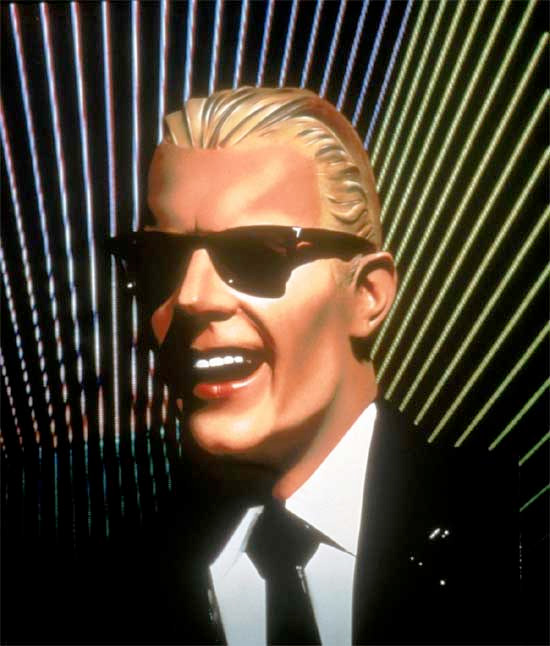Chapter 12: Analog approaches, non-linear editing, and compositing
12.4 Quantel

Quantel was founded by Peter Michael in 1973 in Newbury, UK[1]. It’s focus was to create technology for use in television production. Its first product was the DFS 3000, which was the first digital frame-store. The DFS 3000 is most widely known as the device that allowed the first inset video for television broadcast, a video image inset into the main picture showing a close-up of the Olympic torch integrated with video inside the stadium at the 1976 Montreal Olympics. They followed this with a series of digital effects devices, including the DPE 5000 and the DLS 6000.
Movie 12.5 Quantel – PIP
The Olympic flame was integrated into a video of the stadium in a Quantel box, as the first Picture-In-Picture
The most widely known Quantel product was the Paintbox, introduced in 1981 and still in production at facilities all over the world. The Paintbox was considered one of the first commercial paint systems, and was actually introduced at the spring NAB show in 1980. Quantel obtained patents related to the system, and challenged the entire digital image community with a series of controversial infringement lawsuits. (See the sidebar for more information about these proceedings.) The Paintbox spawned a range of digital technologies from Quantel.
The next device was released in 1982, Called the Mirage, it was the first digital effects machine able to manipulate 3D images in 3D space. It also used an interesting method for transforming one image into another by using a two-dimensional “particle system” to map pixels from one image onto pixels from the second image. As the pixel tiles moved over time, the first image appears to disintegrate and then restructure itself into the second image.
Another radical leap was made in 1986 when Quantel introduced Harry, the world’s first non-linear editor. NLEs became fairly standard in the editing business, making linear editing suites largely obsolete. In some ways Harry did for video editors what Paintbox had done for graphic designers, giving them a tool for moving their trade forward by leaps and bounds. The Harry combined several minutes of digital-disk storage with a 2D graphics system and a crude but elegant means to assemble video clips. It was the only digital non-linear editing workstation capable of producing broadcast-quality material for almost a decade.
Other important Quantel contributions can be seen below from their company timeline:
- 1975: DFS 3000 The world’s first digital framestore.
- 1977: DSC 4002 The first portable digital standards converter.
- 1978: DPE 5000 The first commercially successful digital effects machine.
- 1980: DLS 6000 Digital still storage for on-air presentation.
- 1981: Paintbox The industry standard graphics kit.
- 1982: Mirage The first digital effects machine able to manipulate 3D images in 3D space.
- 1986: Harry The first NLE also makes multilayering of live video a practical proposition.
- 1989: V-series The second generation Paintbox. Faster, smaller and more powerful
- 1990: Picturebox Integrates the storage, presentation and management of stills.
- 1990: Harriet Manipulating live graphics over video.
- 1992: Henry The effects editor. Offers simultaneous layering of multiple live video sources.
- 1992: Hal The video design suite. The first dedicated graphics and compositing centre.

Note: The Paintbox was used extensively in producing the graphics for the 1985 British television series Max Headroom.
There were several other video image manipulation technologies that competed with the Harry. For example, in 1981 Ampex introduced the ADO® system, which created digital special effects, allowing rotation and perspective of video images.
The earliest digital compositing suites for video were Quantel’s dedicated hardware systems, like the Harry. Quantel’s Domino console first evolved the power to take digital compositing to film resolutions. Many post houses used Quantel systems for their ability to process large dataflows in real time (something that later, open systems running on PCs and offering the flexibility of multiple software use were often less able to provide).
Flame, developed by Australian Garry Tregaskis was the first software-only system to run on the Silicon Graphics platform as the general computing power needed to process layers of video and effects became available. Part of the appeal was that these were hardware units which could also be devoted to other tasks, such as editing and 3D graphics.
A plethora of software products running on Unix and NT systems followed. Some evolved from the proprietary software of production studios like ILM or Digital Domain, or NYPD in Australia, in the case of Digital Fusion. Others were developed from the ground up as commercial products by the creators of non-linear editing, 3D or other graphics systems. Adobe’s After Effects, one of the least expensive desktop video compositors, is still basically an adaption of Photoshop with keyframe animation.
Movie 12.6 Max Headroom
Max Headroom: 20 Minutes into the Future is a 1985 cyberpunk television movie created by Chrysalis Visual Programming Ltd. for Channel 4 in the UK to provide a back story for Max Headroom, a computer generated TV host. The series also ran in the U.S. from 1987-1988.
Dick Phillips wrote about the Quantel lawsuits in a 1998 SIGGRAPH newsletter. The following is an excerpt from the article, which can be read in its entirety at
https://ohiostate.pressbooks.pub/app/uploads/sites/45/2017/03/PhillipsQuantel.pdf
“In fact, it was as recent as 1996 that digital paint systems became the subject of a lawsuit. This is surprising, especially when you consider that [Smith97] points out that the first digital paint program can be traced back to 1969. But it was indeed in January 1996 that Adobe Systems Inc. was sued by Quantel Ltd. for alleged infringement of five of their patents by Adobe’s Photoshop product. The stakes were huge; Quantel was seeking damages of $138 million, to be trebled if willful infringement was determined. Moreover, Quantel was seeking an injunction to stop Adobe from selling Photoshop.”
- Quantel acquired Snell in 2013, and rebranded as Snell Advanced Media (SAM) in 2015. In 2018, SAM was acquired by Grass Valley. ↵
